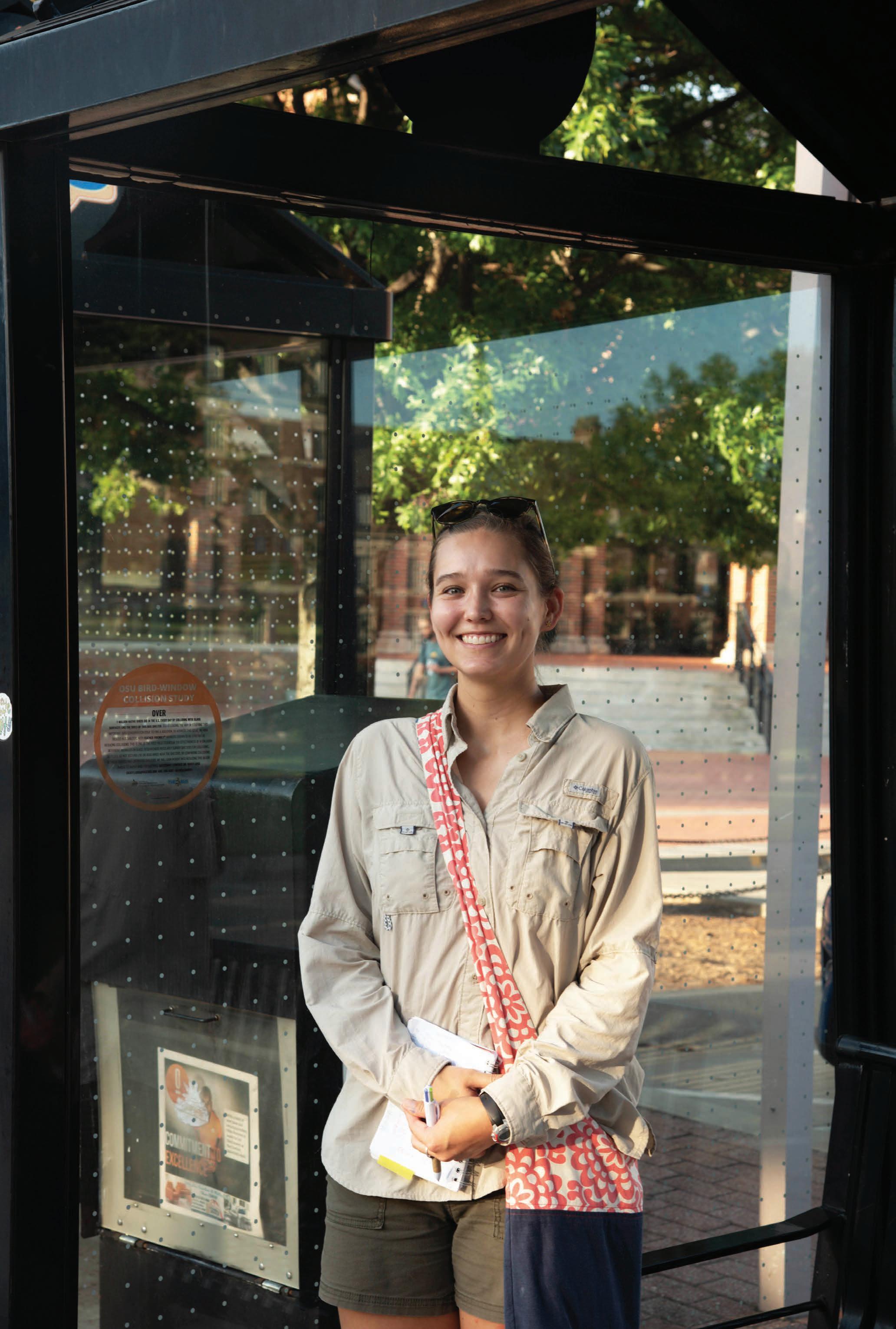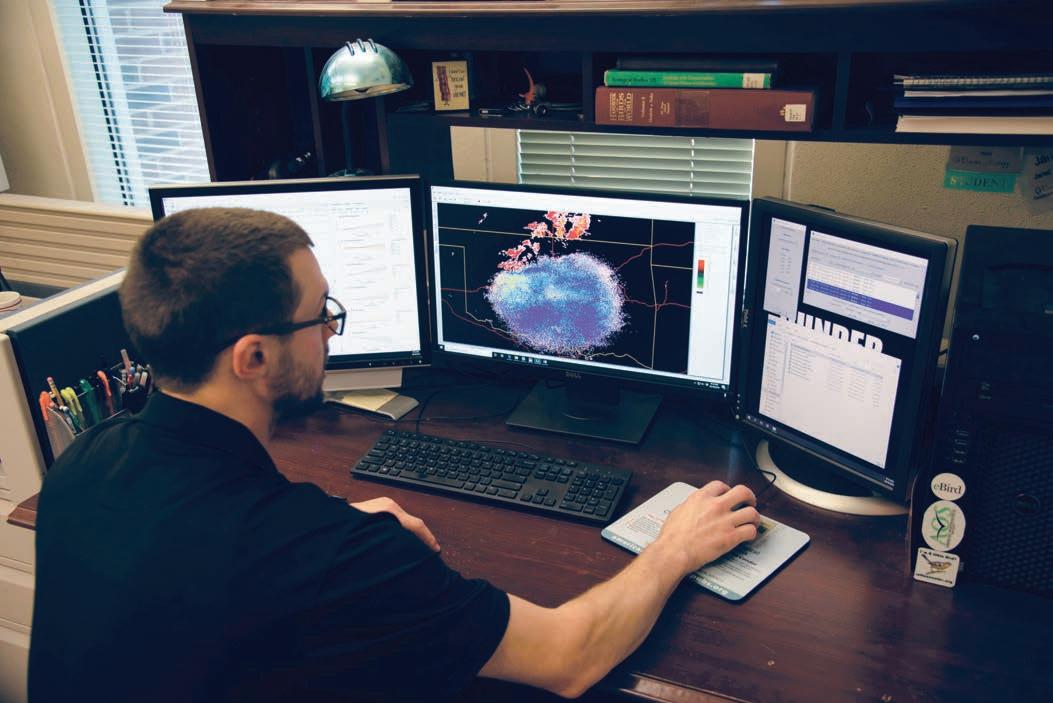
6 minute read
Collision Control
from Cowboy Journal v22n1
Collision Control
From bus shelters to radars, a DASNR researcher and his team work to keep birds safer
Advertisement
Windows provide a source of natural light in man-made structures. They also allow for unique and beautiful architecture, but windows can be fatal to birds.
At Oklahoma State University, researchers are working to predict and prevent bird-window collisions, which are one of the biggest threats for migrating birds.
As lead researcher, Scott Loss, associate professor in natural resource ecology and management, has focused his team’s efforts toward reducing these collisions.
“Relatively few researchers are working on bird-window collisions today especially in comparison to other threats like wind energy, communication towers and structures that cause collisions,” Loss said. “Windows are the No. 1 collision threat, causing up to a billion bird fatalities in the U.S. a year.”
Part of the reason for the collisions is the difference in eye structure between birds and humans, Loss said.
“In our eyes, we have only one kind of rod and a couple of kinds of cones,” Loss said. “Birds have an extra type of cone in their eyes, and in many species it’s sensitive to the UV spectrum.
“They’re actually seeing in a way we can’t understand or envision,” he added.
To reduce the rate of bird collisions, windows simply need to be more visible to birds, Loss said. Incorporating how a bird sees into building design would be a more effective strategy than focusing only on how humans see, he added.
“Ultimately, if you have that understanding of how birds see a building, then you could tweak the building in ways to help the birds see the windows,” Loss said.
Adding a visual barrier to the window is one way to accomplish this, Loss said.
Georgia Riggs, NREM master’s student, uses the bus shelters at OSU to test one type of visual barrier.
“A grid of individual markers is placed on a sheet pane of glass,” Riggs said. “The markers break the reflectivity and transparency of the glass, so birds can detect it as a barrier.”
The markers are developed by the company, Feather Friendly, Riggs said. They are round, white dots placed in a grid pattern.
“There was a baseline study done here in Stillwater in 2016 looking at the bus shelters to see how many birds collide with shelters,” Riggs said. “It found that a lot of birds were colliding with these glass-walled bus shelters.”

In her research that may help minimize bird-window collisions, Georgia Riggs uses a grid of dots on OSU bus stops.
Photo by Harrison Hill.
Riggs used this data to decide which shelters to treat. She had the grid applied to 18 shelters in Stillwater, leaving 18 others as a control group.
The shelters have glass walls on their three closed sides. The treated shelters have the markers applied completely around their exterior surfaces.
“The American Bird Conservancy tested the markers in controlled conditions,” Riggs said. “They have a lot of anecdotal evidence that the markers work in field conditions, but few studies have tested it in field conditions.”
Riggs chose the bus stops for several reasons, she said.
“There have been a lot more studies done on various buildings,” Riggs said. “This is the only study that’s been done at bus shelters.”
This is a different way to look at collisions since they can happen anywhere, Riggs said.
“A good number of collisions happen at people’s homes, which I would imagine is more like a bus shelter than a tall building,” Riggs said.
Riggs alternates the shelters she checks each morning. At each shelter, she first checks for any birds on the ground, she said. Then, she looks for signs of a collision and records the data in a notepad.
Her main goal is to reduce the mortality rate from bird-window collisions, Riggs said. All glass can be deadly to a bird, she added.
“As our human population grows, our urban settings are going to grow, so it’s important that we consider how wildlife is affected,” Riggs said. “There’s a lot of value to be had in integration of humans and wildlife.”
Integration of birds into modern human society is what got Riggs interested in urban ecology, she said.
“I don’t think it has to be so black and white,” Riggs said. “We do not have to have an area where no people are allowed and then have cities where we do not want wildlife. I really think that we can all coexist.”
Not all collision research happens in the field. Jared Elmore, NREM doctoral student, uses computer and radar data to better understand and predict bird movements and when collisions will occur.

American robins are one of the more common types of birds to collide with buildings on OSU’s campus. Birds like this robin contribute to the eco-tourism industry of bird watching. In 2006, birding contributed more than $36 billion to the U.S. economy.
Photo by Alan B. Schroeder.
“There has been an explosion of research from a couple of labs that are using radar to understand bird migration,” Loss said. “Radar has definitely come more into the forefront of bird ecology in the last few years.”
Elmore uses data from the NEXRAD network, a system of 143 radars across the continental U.S. mainly used to collect weather data, he said. But these radars also bounce off flying birds and insects, he said.
A meteorologist would remove any data that is not weather but Elmore does the opposite.
“The radar sends out energy and when the energy reflects off of an object, that comes back to the radar,” Elmore said. “It collects information about how reflective the object was, its location and some data about the size and direction it was going.”
Besides removing weather data, Elmore removes information about objects too small or too large to be birds. The result allows Elmore to see when a large population of migratory birds fly over an area.
“Any time you have a lot of birds flying in the air, you are more likely to get collisions,” Elmore said. “That’s common sense. The problem is no one’s ever paired what we actually see on the ground, in terms of numbers of collisions, with what is in the airspace.”
Advances in radar and computer processing during the past few years allow Elmore to predict bird movements, he said.
Migratory birds fall victim to collisions at a higher frequency than others, Loss said. Radars help to quantify these migrations, he added.
Radar and machine predictions linked with ground observations help researchers understand bird movements, Loss said. Documenting this link would inform policy and building plans to better prevent collisions, he added.
Paying attention to these things is important because birds serve a vital role in both the economy and the ecosystem, Elmore said.
“One example: How many people hate insects?” Elmore asked. “If you had huge declines in birds, which eat a large number of insects, then your insect population is going to increase.”
Birds’ economic value can be measured through birders, people who enjoy recreational bird watching, Elmore said. They will travel and spend money just to see different birds, he added.
“If you include birding as a sport, it would be the most popular sport in the world,” Elmore said. “Think about how many people have bird feeders and sit in the morning, drinking their coffee and watching birds.”
Recently, a group of scientists estimated the size of the North American breeding bird population was 3 billion birds fewer than in 1970, Loss said.
“There are all sorts of different things contributing to that, from habitat loss to these more direct threats like collisions,” Loss said.
Loss is optimistic bird conservation will enter more into the public consciousness soon, he said. He and his team hope to see bird-friendly building design as a recurrent topic of conversation, he added.
“Can we find a way to balance windows and bird populations?” Loss asked. “We should have windows, but there are ways to design buildings and windows to be less deadly to birds.”
A lot of people see birds daily but do not think much about it, Riggs said. “Birds provide a lot of services for us,” Riggs added.
“They are really important for ecosystems, and they are something we need to pay attention to and protect.”

Jared Elmore studies NEXRAD radar system data to predict bird movements. On the screen, red areas indicate weather while the blue/green areas indicate birds and insects.
Photo by Harrison Hill.
By Harrison Hill |Oklahoma City, Oklahoma



